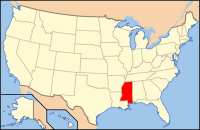Carroll County, MS
| Carroll County, Mississippi | |
|---|---|

Carroll County Courthouse
|
|
 Location in the U.S. state of Mississippi |
|
 Mississippi's location in the U.S. |
|
| Founded | 1833 |
| Named for | Charles Carroll of Carrollton |
| Seat |
Carrollton (Northern District) Vaiden (Southern District) |
| Largest town | Vaiden |
| Area | |
| • Total | 635 sq mi (1,645 km2) |
| • Land | 628 sq mi (1,627 km2) |
| • Water | 6.3 sq mi (16 km2), 1.0% |
| Population | |
| • (2010) | 10,597 |
| • Density | 17/sq mi (7/km²) |
| Congressional district | 2nd |
| Time zone | Central: UTC-6/-5 |
Carroll County is a county located in the U.S. state of Mississippi. As of the 2010 census, the population was 10,597. Its county seats are Carollton and Vaiden. The county is named for Charles Carroll of Carrollton, the last surviving signatory of the U.S. Declaration of Independence.
Carroll County is part of the Greenwood, MS Micropolitan Statistical Area. Bordered by the Yazoo River on the west and the Big Black River to the east, it is considered within the Mississippi Delta region. Most of its land is in the hill country.
The Porter Wagoner song "The Carroll County Accident" was set here. The county is referred to in the third verse of Bobbie Gentry's 1967 hit song, "Ode to Billie Joe".
This area was developed by European Americans for cotton plantations near the rivers. After the American Civil War, many freedmen worked as sharecroppers or tenant farmers on the plantations. Other areas were used for timber. In 1890 the state legislature disenfranchised most blacks, who were a majority in the state, by creating barriers to voter registration; it also passed Jim Crow laws, treating freedmen and their descendants as second-class citizens.
...
Wikipedia
